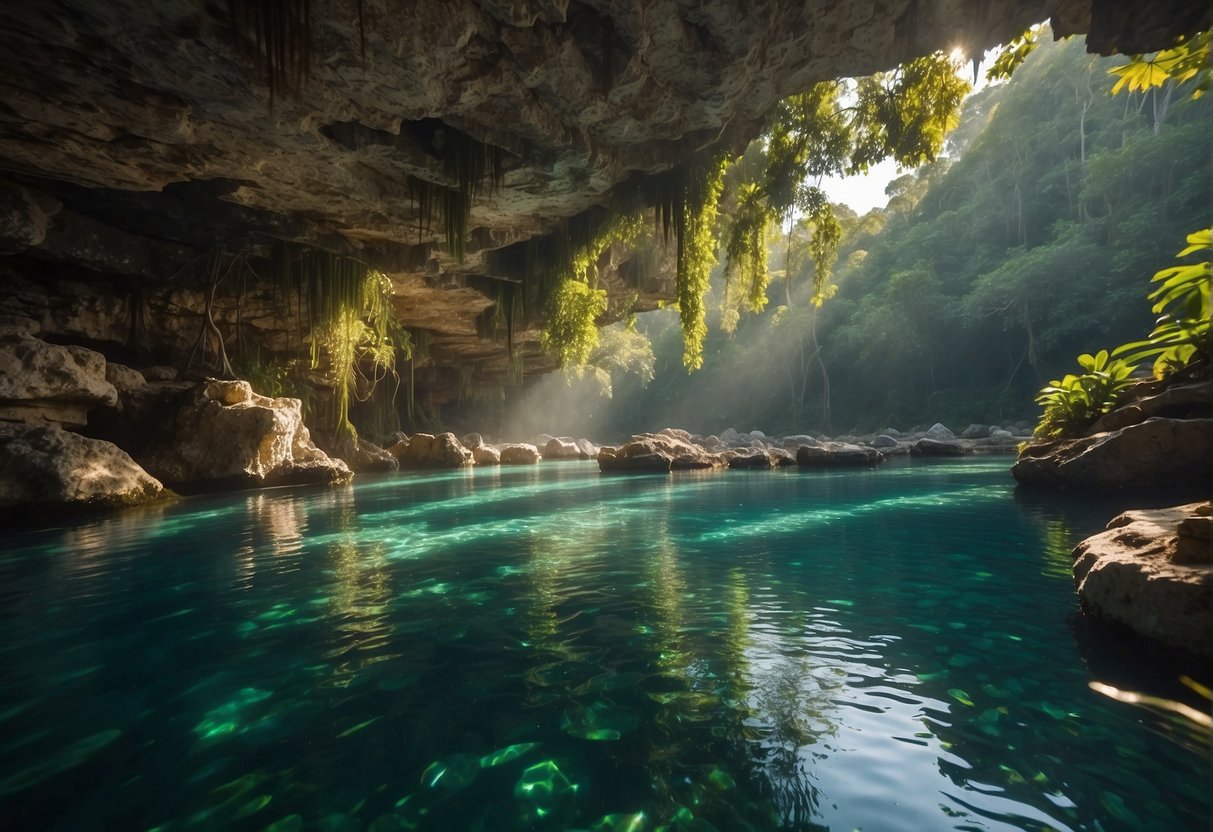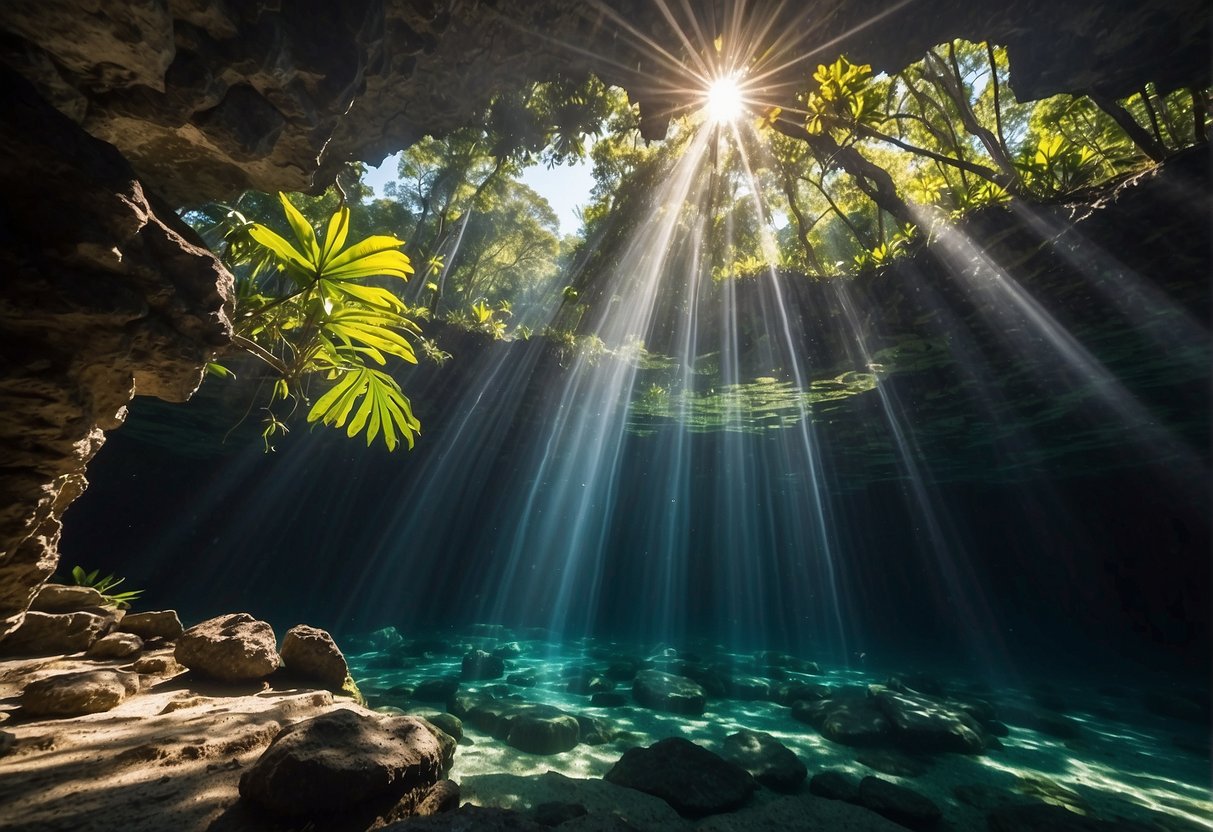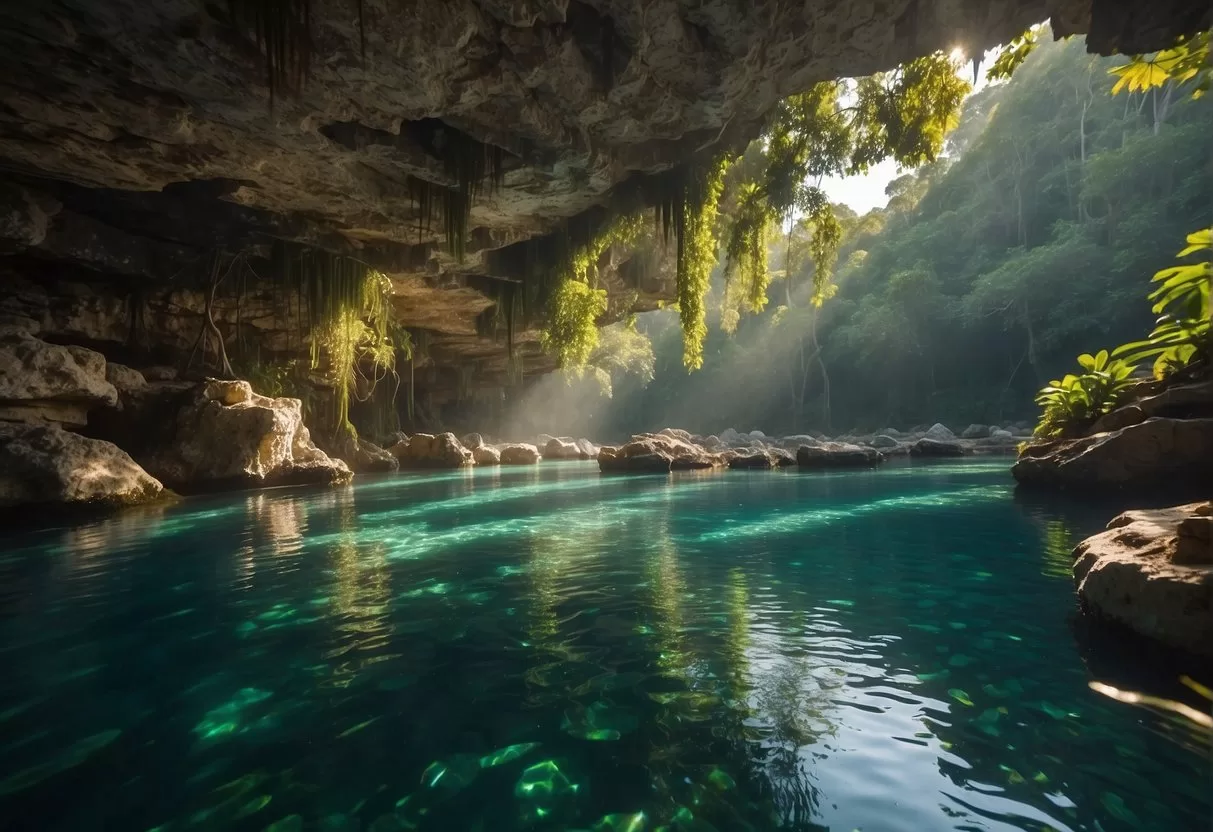Cenote Cuzama is a stunning natural wonder located in the Yucatan Peninsula of Mexico. A cenote is a natural sinkhole that is created when the limestone bedrock collapses, exposing the groundwater underneath. Cenotes are unique to this region of the world and are considered sacred by the Mayan people who have lived here for thousands of years.

Exploring Cenote Cuzama is an adventure that takes visitors on a journey through the jungle. Visitors ride in a horse-drawn cart on an old train track. The journey takes visitors to three different cenotes, each with its own unique beauty and features. Visitors can swim in the crystal-clear waters, explore the underwater caves, or simply relax and take in the natural beauty of the surroundings.
Travel and Accessibility to Cenote Cuzama is relatively easy. Many tour operators offer guided tours from the nearby city of Merida. The journey takes approximately one hour by car, and visitors can expect to spend three to four hours exploring the cenotes. It is important to note that the cenotes are located in a natural environment, and visitors should be prepared for the elements, including heat, humidity, and insects.
Key Takeaways
- Cenote Cuzama is a natural wonder located in the Yucatan Peninsula of Mexico, and is considered sacred by the Mayan people.
- Exploring Cenote Cuzama is an adventure that takes visitors through the jungle, riding in a horse-drawn cart on an old train track.
- Visitors can swim in the crystal-clear waters, explore the underwater caves, or relax and take in the natural beauty of the surroundings.
Exploring Cenote Cuzama
As an adventurous traveler, I highly recommend exploring the three stunning cenotes that make up Cenote Cuzama. Each cenote has its unique charm and beauty, making it a worthwhile experience.
Cenote Chelentun
Cenote Chelentun is the first cenote you’ll encounter on your adventure through Cenote Cuzama. This underground cenote features crystal-clear water, allowing you to see the beautiful stalactites and stalagmites beneath the surface. The water is also warm, making it perfect for swimming.
Cenote Chunkanán
Cenote Chunkanán is the second cenote on the route. This cenote is larger than Cenote Chelentun and features a stunning natural skylight. The skylight allows sunlight to filter through the water and illuminate the underground cave. The water is also incredibly clear, making it easy to see the various fish and plant life that call this cenote home.
Cenote X’tohil
Cenote X’tohil is the final cenote on the route. This cenote is smaller than the previous two but is still incredibly beautiful. The water is crystal-clear, and the cenote features stunning rock formations that are perfect for exploring.
Overall, exploring Cenote Cuzama is an adventure that you won’t want to miss. The underground cenotes are breathtaking, and the clear water provides an opportunity to see the stunning rock formations beneath the surface. If you’re ever in Yucatan, I highly recommend adding Cenote Cuzama to your adventure list.
Travel and Accessibility to Cenote Cuzama
Getting to Cuzama
If you are planning to visit the Cuzama Cenotes, you will likely be coming from Merida or Valladolid. The best way to get to Cuzama from Merida is by taking a bus from the Noreste Bus Station. The bus ride takes about an hour and a half and costs around 30 pesos. If you are coming from Valladolid, you can take a colectivo or taxi to Cuzama.
Once you arrive in Cuzama, you will need to make your way to the entrance of the cenotes. The entrance is located on the main road and is easy to find. From there, you have a few options for getting to the cenotes themselves.
Navigating the Cenotes
The most popular way to get to the Cuzama Cenotes is by taking a truck ride. A horse pulls the modified trucks, which fit on the narrow-gauge railway tracks. The ride is bumpy but fun, and it takes you through the jungle to the first cenote. From there, you can climb down a wooden staircase to the water.
If you are not comfortable with the truck ride, you can also take a motorcycle taxi to the cenotes. The motorcycle taxis are faster and more convenient but also more expensive. You can negotiate the price with the driver before you get on.
There is an entrance fee to the Cuzama Cenotes, currently 80 pesos per person. The cenotes are open from 9 am to 5 pm, so plan your visit accordingly.
Overall, getting to and navigating the Cuzama Cenotes is relatively straightforward. Whether you take a truck or a motorcycle taxi, you will surely have an unforgettable experience exploring these natural wonders.
Visitor Experience
Activities and Amenities
When visiting the Cenote Cuzama, visitors can enjoy a variety of activities. The cenotes are perfect for swimming and offer a refreshing escape from the heat of the Yucatan Peninsula. Visitors can also take advantage of the rope swing available at the cenote to make their experience even more exciting.
For safety reasons, life jackets are provided to all visitors. A ladder and stairs are also available to make getting in and out of the cenote easier. Visitors should bring their own towel and camera to capture the beauty of the cenote.
Local guides are available to provide information about the cenote and its history. Visitors can also rent a mask to explore the underwater world of the cenote.
Safety and Guidelines for Cenote Cuzama
It is important to follow safety guidelines when visiting the Cenote Cuzama. Visitors should wear appropriate swimwear and avoid jumping or diving into the cenote. The rope swing should only be used under the supervision of a local guide.
Visitors should be aware of the wait time to enter the cenote, as it can get crowded during peak hours. The length of the visit can vary depending on the activities chosen. Visitors should also be mindful of their belongings and avoid bringing valuables to the cenote.
Reviews on TripAdvisor suggest that visitors should bring their own food and drinks as there are limited options available at the cenote. Overall, visitors should come prepared with sunscreen, insect repellent, and plenty of water to ensure a comfortable and enjoyable experience.
Conservation and Culture of Cenote Cuzama

Environmental Significance
As a result of the unique geological formation of the Yucatán Peninsula, Cenotes like Cuzama are abundant in the region. These natural sinkholes formed by the collapse of limestone bedrock reveal underground rivers and caves that are home to a diverse range of flora and fauna.
The jungle surrounding the Cenotes is an important habitat for a variety of animal species, such as monkeys, jaguars, and snakes. The tree roots that dangle into the water provide a natural filtration system, which helps to maintain the water’s clarity and purity.
Conservation efforts have been put in place to protect these fragile ecosystems. Visitors are encouraged to respect the rules and regulations put in place to help preserve the natural beauty of the Cenotes. It is important to note that sunscreen, insect repellent, and other chemicals can harm the delicate balance of the ecosystem, so it is recommended to use environmentally friendly products when visiting.
Historical Relevance
Cenotes have played an important role in the history and culture of the Mayan civilization. The ancient Mayans considered these natural wonders sacred. They believed that they were the dwelling places of the gods.
Today, the Cenotes serve as a reminder of the rich cultural heritage of the Yucatán Peninsula. The Cuzama Cenotes are located just a short distance from the city of Mérida. They are easily accessible for visitors interested in exploring the history and culture of the region.
In recent years, there has been an increased focus on promoting sustainable tourism in the region. Transparency reports provide visitors with information on the environmental and social impact of their visit. By supporting responsible tourism practices, visitors can help to ensure that the Cuzama Cenotes and other natural wonders of the Yucatán Peninsula are preserved for future generations to enjoy.





